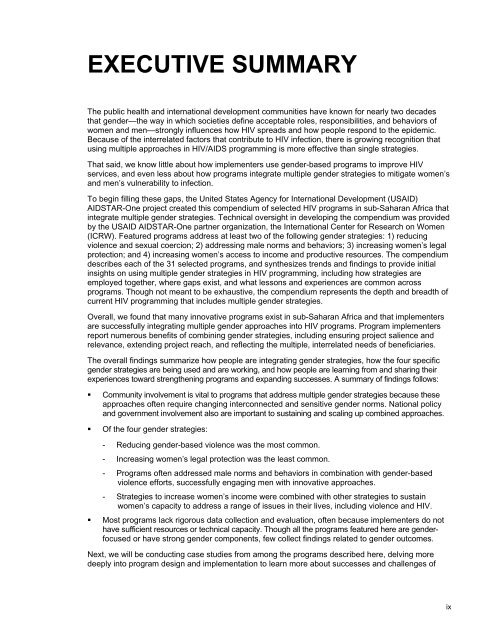Implementing Multiple Gender Strategies to Improve HIV and ... - ICRW
Implementing Multiple Gender Strategies to Improve HIV and ... - ICRW
Implementing Multiple Gender Strategies to Improve HIV and ... - ICRW
You also want an ePaper? Increase the reach of your titles
YUMPU automatically turns print PDFs into web optimized ePapers that Google loves.
EXECUTIVE SUMMARY<br />
The public health <strong>and</strong> international development communities have known for nearly two decades<br />
that gender—the way in which societies define acceptable roles, responsibilities, <strong>and</strong> behaviors of<br />
women <strong>and</strong> men—strongly influences how <strong>HIV</strong> spreads <strong>and</strong> how people respond <strong>to</strong> the epidemic.<br />
Because of the interrelated fac<strong>to</strong>rs that contribute <strong>to</strong> <strong>HIV</strong> infection, there is growing recognition that<br />
using multiple approaches in <strong>HIV</strong>/AIDS programming is more effective than single strategies.<br />
That said, we know little about how implementers use gender-based programs <strong>to</strong> improve <strong>HIV</strong><br />
services, <strong>and</strong> even less about how programs integrate multiple gender strategies <strong>to</strong> mitigate women’s<br />
<strong>and</strong> men’s vulnerability <strong>to</strong> infection.<br />
To begin filling these gaps, the United States Agency for International Development (USAID)<br />
AIDSTAR-One project created this compendium of selected <strong>HIV</strong> programs in sub-Saharan Africa that<br />
integrate multiple gender strategies. Technical oversight in developing the compendium was provided<br />
by the USAID AIDSTAR-One partner organization, the International Center for Research on Women<br />
(<strong>ICRW</strong>). Featured programs address at least two of the following gender strategies: 1) reducing<br />
violence <strong>and</strong> sexual coercion; 2) addressing male norms <strong>and</strong> behaviors; 3) increasing women’s legal<br />
protection; <strong>and</strong> 4) increasing women’s access <strong>to</strong> income <strong>and</strong> productive resources. The compendium<br />
describes each of the 31 selected programs, <strong>and</strong> synthesizes trends <strong>and</strong> findings <strong>to</strong> provide initial<br />
insights on using multiple gender strategies in <strong>HIV</strong> programming, including how strategies are<br />
employed <strong>to</strong>gether, where gaps exist, <strong>and</strong> what lessons <strong>and</strong> experiences are common across<br />
programs. Though not meant <strong>to</strong> be exhaustive, the compendium represents the depth <strong>and</strong> breadth of<br />
current <strong>HIV</strong> programming that includes multiple gender strategies.<br />
Overall, we found that many innovative programs exist in sub-Saharan Africa <strong>and</strong> that implementers<br />
are successfully integrating multiple gender approaches in<strong>to</strong> <strong>HIV</strong> programs. Program implementers<br />
report numerous benefits of combining gender strategies, including ensuring project salience <strong>and</strong><br />
relevance, extending project reach, <strong>and</strong> reflecting the multiple, interrelated needs of beneficiaries.<br />
The overall findings summarize how people are integrating gender strategies, how the four specific<br />
gender strategies are being used <strong>and</strong> are working, <strong>and</strong> how people are learning from <strong>and</strong> sharing their<br />
experiences <strong>to</strong>ward strengthening programs <strong>and</strong> exp<strong>and</strong>ing successes. A summary of findings follows:<br />
• Community involvement is vital <strong>to</strong> programs that address multiple gender strategies because these<br />
approaches often require changing interconnected <strong>and</strong> sensitive gender norms. National policy<br />
<strong>and</strong> government involvement also are important <strong>to</strong> sustaining <strong>and</strong> scaling up combined approaches.<br />
• Of the four gender strategies:<br />
- Reducing gender-based violence was the most common.<br />
- Increasing women’s legal protection was the least common.<br />
- Programs often addressed male norms <strong>and</strong> behaviors in combination with gender-based<br />
violence efforts, successfully engaging men with innovative approaches.<br />
- <strong>Strategies</strong> <strong>to</strong> increase women’s income were combined with other strategies <strong>to</strong> sustain<br />
women’s capacity <strong>to</strong> address a range of issues in their lives, including violence <strong>and</strong> <strong>HIV</strong>.<br />
• Most programs lack rigorous data collection <strong>and</strong> evaluation, often because implementers do not<br />
have sufficient resources or technical capacity. Though all the programs featured here are genderfocused<br />
or have strong gender components, few collect findings related <strong>to</strong> gender outcomes.<br />
Next, we will be conducting case studies from among the programs described here, delving more<br />
deeply in<strong>to</strong> program design <strong>and</strong> implementation <strong>to</strong> learn more about successes <strong>and</strong> challenges of<br />
ix
















